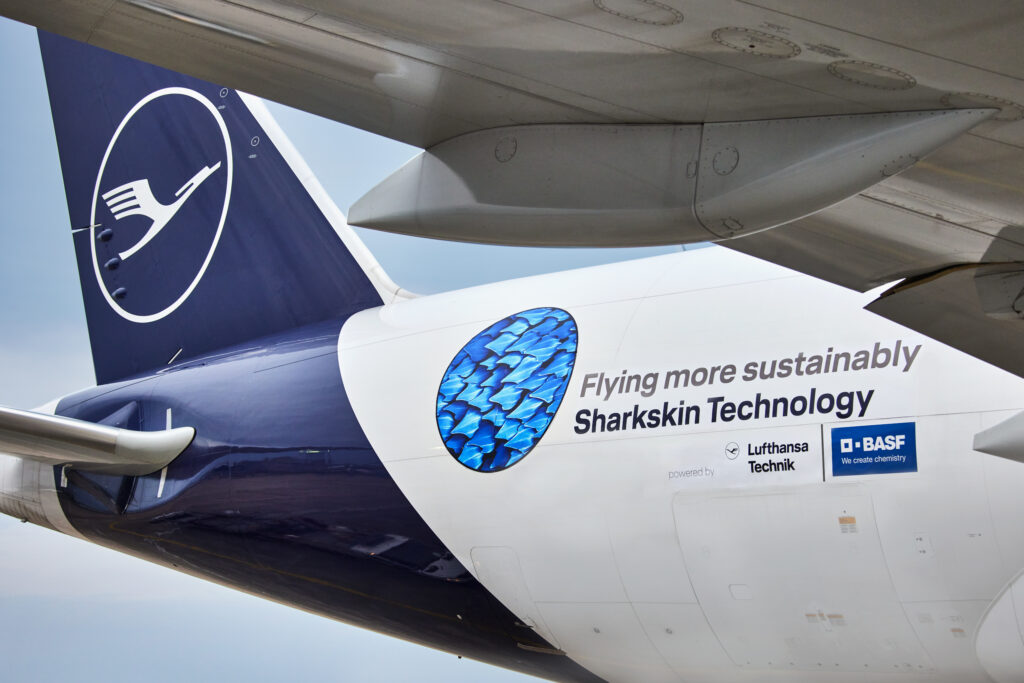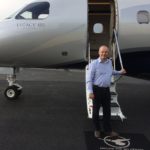 Swiss International Airlines (SWISS) has been flying an AeroSHARK-treated Boeing 777-300ER aircraft in revenue service since 14 October 2022. Now the carrier has equipped all 12 of its 777-300ER twinjets with the drag-reducing technology from Lufthansa Technik and BASF.
Swiss International Airlines (SWISS) has been flying an AeroSHARK-treated Boeing 777-300ER aircraft in revenue service since 14 October 2022. Now the carrier has equipped all 12 of its 777-300ER twinjets with the drag-reducing technology from Lufthansa Technik and BASF.
A multi-layer film in which different polymer materials are precisely matched to each other, AeroSHARK has millions of ribs around 50 micrometres in size, known as riblets. They mimic the properties of sharkskin, optimizing aerodynamics at flow-relevant points on the aircraft, including the fuselage and engine nacelles.
Some 950m2 of AeroSHARK film, weighing 160kg, is applied to each Boeing 777. SWISS’ modified 777 fleet could save around 4,800 tonnes of fuel and 15,200 tonnes of CO₂ per year based on its specific operating profile, according to Soenke Burger, head of avionics & flight ops solutions at Lufthansa Technik (LHT).
“We estimate that the cost of the AeroSHARK modification will be amortized within about two years and that’s without considering any savings on future charges for CO₂ emissions,” he told RGN.
Treating each SWISS 777 with AeroSHARK took around a week, with company technicians applying the product. For its part, LHT provided airline maintenance staff training, and made itself available to offer advice and support during the application process. The application can be completed during regular maintenance checks, but SWISS scheduled special layovers to finish all 12 777s within 18 months.
“Most of the time is spent applying approximately 3,000 patches to the aircraft surface according to a flow-optimized design layout. Very few patches need to be cut to shape and even then the task is brief. Film is carefully applied to moving parts and access panels to ensure there is no interference in their operation,” explained Burger.
SWISS is already recording impressive fuel and emissions savings, but sustainability solutions are about more than direct effect. The airline has taken AeroSHARK’s weight into account in its published numbers, but allowance has yet to be made for degradation in service, removal when the aircraft skin needs repainting, and repair or reduced effectiveness should the film suffer damage. None of these issues cause Berger any concern, however.
Following extensive testing and a certification process lasting several months, EASA and the FAA granted LHT a Supplemental Type Certificate (STC) for AeroSHARK application on the 777-300ER and 777F. BASF and LHT also tested for durability, Burger said. “In the laboratory we tested for the effects of abrasion and deicing fluid, and for UV resistance, confirming the film meets the highest requirements for daily flight operations.
“Of course, there’s a possibility that a bird strike or contact with a ground vehicles might damage the riblet structure, but the aircraft skin would also require inspection and repair. Even if there are isolated gaps in coverage, AeroSHARK’s overall drag-reducing effect still outstrips the efficiency of conventional aircraft paint.”
AeroSHARK has been flying on a Lufthansa 747-400 since 2019 and Burger reports it attracts dirt less than regular aircraft paint. Nonetheless, he cautioned: “Regular wash cycles are unchanged by the film, but our ‘shark’ likes water and dry washing is not permitted, since the process would damage the riblet structures.”
Burger noted that AeroSHARK test patches on the 747-400 remain in good condition after more than four years but advised that, as is common with regular aircraft coatings, it is vulnerable to extensive spills of Skydrol hydraulic fluid, while there are no restrictions on deicing.
AeroSHARK is designed to adhere reliably for the four-year period between 2C maintenance checks and therefore also resists the large temperature and pressure differences typical in commercial flight. Work to optimize the removal process is continuing.

Lufthansa has been flying AeroSHARK on a 747-400 operational testbed since 2019. Image: Lufthansa Technik
As well as the SWISS 777-300ERs and Lufthansa 747-400, AeroSHARK has been applied to four Lufthansa Cargo 777F aircraft. Over the medium-term, SWISS is considering extending its AeroSHARK programme to further types in its long-haul fleet – presumably the A330 and A340. And, Burger confirms, “We have received serious interest from several other airlines and look forward to announcing additional customers soon.”
Related Articles:
- Lufthansa Technik explains AeroSHARK as 777F with riblets flies
- Germany’s new aviation tax hike elicits rebuke from industry
- Airbus powers on ZEROe fuel cell, eyes A380 test flights in 2026
- A350 testbed demos ‘most energy efficient flight’ in advance of 4D
- Lufthansa Systems helps airlines go green with cadre of digital tools
Featured image credited to SWISS












